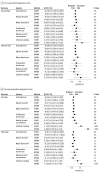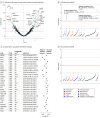Major Psychiatric Disorders, Substance Use Behaviors, and Longevity
- PMID: 38888899
- PMCID: PMC11195603
- DOI: 10.1001/jamapsychiatry.2024.1429
Major Psychiatric Disorders, Substance Use Behaviors, and Longevity
Abstract
Importance: Observational studies suggest that major psychiatric disorders and substance use behaviors reduce longevity, making it difficult to disentangle their relationships with aging-related outcomes.
Objective: To evaluate the associations between the genetic liabilities for major psychiatric disorders, substance use behaviors (smoking and alcohol consumption), and longevity.
Design, settings, and participants: This 2-sample mendelian randomization (MR) study assessed associations between psychiatric disorders, substance use behaviors, and longevity using single-variable and multivariable models. Multiomics analyses were performed elucidating transcriptomic underpinnings of the MR associations and identifying potential proteomic therapeutic targets. This study sourced summary-level genome-wide association study (GWAS) data, gene expression, and proteomic data from cohorts of European ancestry. Analyses were performed from May 2022 to November 2023.
Exposures: Genetic susceptibility for major depression (n = 500 199), bipolar disorder (n = 413 466), schizophrenia (n = 127 906), problematic alcohol use (n = 435 563), weekly alcohol consumption (n = 666 978), and lifetime smoking index (n = 462 690).
Main outcomes and measures: The main outcome encompassed aspects of health span, lifespan, and exceptional longevity. Additional outcomes were epigenetic age acceleration (EAA) clocks.
Results: Findings from multivariable MR models simultaneously assessing psychiatric disorders and substance use behaviorsm suggest a negative association between smoking and longevity in cohorts of European ancestry (n = 709 709; 431 503 [60.8%] female; β, -0.33; 95% CI, -0.38 to -0.28; P = 4.59 × 10-34) and with increased EAA (n = 34 449; 18 017 [52.3%] female; eg, PhenoAge: β, 1.76; 95% CI, 0.72 to 2.79; P = 8.83 × 10-4). Transcriptomic imputation and colocalization identified 249 genes associated with smoking, including 36 novel genes not captured by the original smoking GWAS. Enriched pathways included chromatin remodeling and telomere assembly and maintenance. The transcriptome-wide signature of smoking was inversely associated with longevity, and estimates of individual smoking-associated genes, eg, XRCC3 and PRMT6, aligned with the smoking-longevity MR analyses, suggesting underlying transcriptomic mediators. Cis-instrument MR prioritized brain proteins associated with smoking behavior, including LY6H (β, 0.02; 95% CI, 0.01 to 0.03; P = 2.37 × 10-6) and RIT2 (β, 0.02; 95% CI, 0.01 to 0.03; P = 1.05 × 10-5), which had favorable adverse-effect profiles across 367 traits evaluated in phenome-wide MR.
Conclusions: The findings suggest that the genetic liability of smoking, but not of psychiatric disorders, is associated with longevity. Transcriptomic associations offer insights into smoking-related pathways, and identified proteomic targets may inform therapeutic development for smoking cessation strategies.
Conflict of interest statement
Figures





References
-
- Parks J, Svendsen D, Singer P, Foti ME. Morbidity and mortality in people with serious mental illness. Vol. 25 2006;87:13.

